In the rapidly evolving world of battery technology, staying up-to-date with the latest transport regulations and safety standards is crucial. Lithium batteries, in particular, have become an integral component of various devices, from smartphones to electric vehicles. However, their potential for thermal runaway and fire hazards necessitates stringent regulations for their transportation. This article will delve into the latest updates in battery transport regulations and the importance of the UN38.3 / 1.2M drop test.
Updates in Battery Transport Regulations
As of my knowledge cutoff in September 2021, the International Air Transport Association (IATA) and the International Maritime Dangerous Goods (IMDG) Code are the primary regulatory bodies for air and sea transport of lithium batteries, respectively. These organizations regularly update their regulations to enhance safety during transportation.
One of the recent significant changes has been the requirement for lithium batteries to be shipped at a state of charge (SoC) not exceeding 30% when transported by air (IATA Dangerous Goods Regulations). This rule aims to minimize the risk of thermal runaway during air transport.
Moreover, the IMDG Code Amendment 40-20, effective from June 2022, introduced new provisions for the transport of lithium batteries damaged or defective for their disposal or recycling. These batteries must be packed in salvage packaging and are forbidden for transport in a cargo transport unit on a passenger vessel.
Understanding the UN38.3 / 1.2M Drop Test
The UN38.3 standard, developed by the United Nations, is a globally recognized set of tests for the safe transport of lithium batteries. These tests cover various aspects, including altitude simulation, thermal test, vibration test, shock test, external short circuit test, impact/crush test, overcharge test, and forced discharge test.
Among these, the 1.2-meter drop test is particularly noteworthy. This test is designed to simulate the conditions that might occur during transport and handling. The battery or battery pack is dropped onto a hard surface from a height of about 1.2 meters. Each of the six faces of the battery or battery pack is subjected to the drop test.
Passing the 1.2M drop test is a testament to the robustness of the battery’s construction and its resistance to damage from impacts. A battery that can withstand this test is less likely to become damaged during transport, reducing the risk of a dangerous incident.
The Importance of Compliance
Compliance with the latest transport regulations and safety standards like UN38.3 is not just a legal requirement – it’s also a matter of public safety. Lithium batteries that are improperly handled or transported can pose significant risks, including fires that are difficult to extinguish.
Moreover, demonstrating compliance with these regulations and standards can also be beneficial from a business perspective. It can enhance a company’s reputation for safety and quality, and it can also avoid the potential costs and disruptions associated with regulatory non-compliance.
In conclusion, as the use of lithium batteries continues to grow, understanding and complying with the latest transport regulations and safety standards will become increasingly important. By staying informed and proactive, businesses can ensure the safe transport of their products, protect public safety, and navigate the regulatory landscape effectively.
































